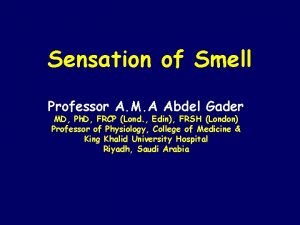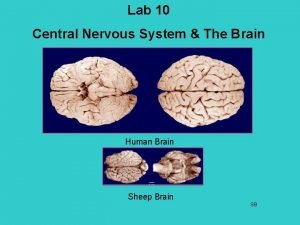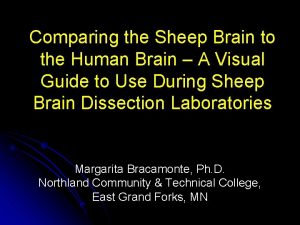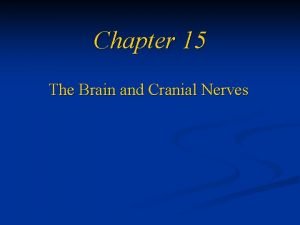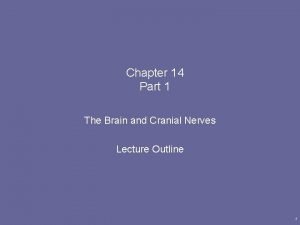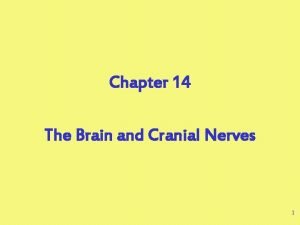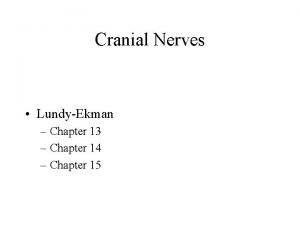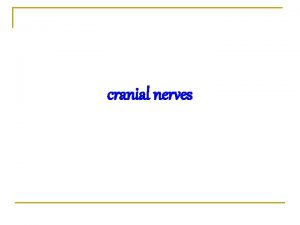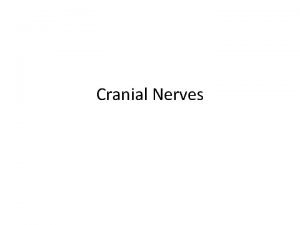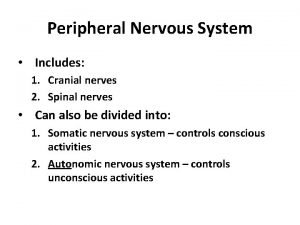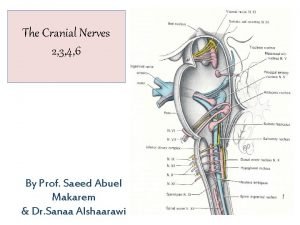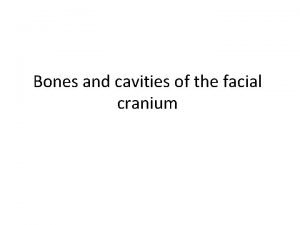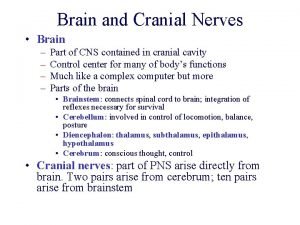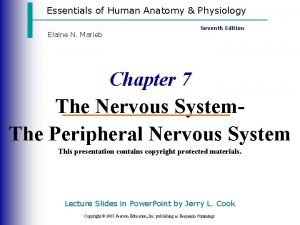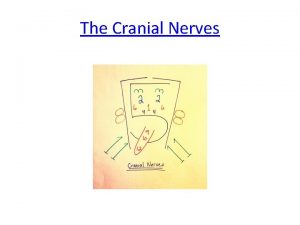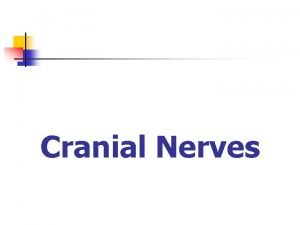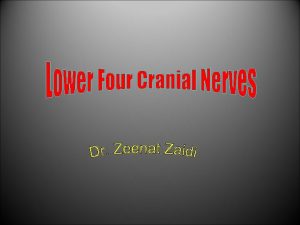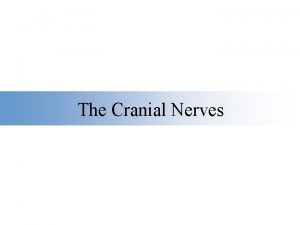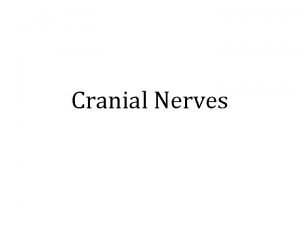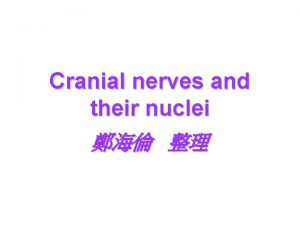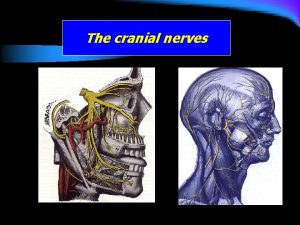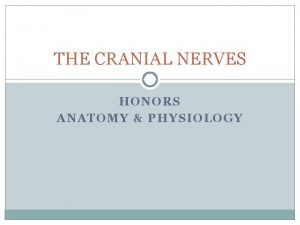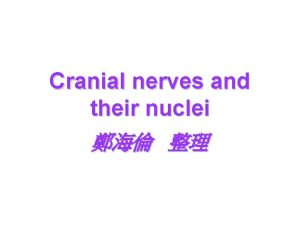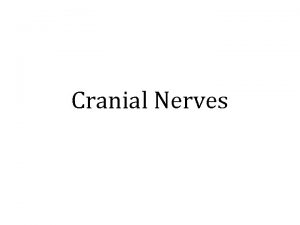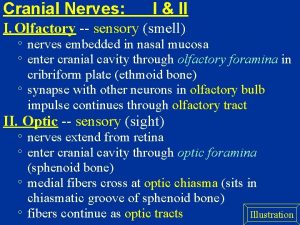Cranial Nerves CN I Olfactory CN II Optic

















- Slides: 17

Cranial Nerves • CN I – Olfactory • CN II – Optic • CN III – Oculomotor • CN IV – Trochlear • CN V – Trigeminal • CN VI – Abducens • CN VII – Facial • CN VIII – Vestibulocochlear • CN IX – Glossopharyngeal • CN X – Vagus • CN XI – Accessory • CN XII – Hypoglossal

Cranial Nerves • Named by structure or function • 12 pairs (e. g. , left and right) • Provide motor and sensory innervation for head and neck (from shoulders up) • Carry motor information from primary motor cortex to muscles • Carry sensory information back to the brain • Some are motor only, sensory only, or mixed

Cranial Nerves • Upper motor neuron (UMN): receive/provide information from the cerebral cortex to the cranial nerve nuclei in the brainstem • Can be bilateral or contralateral • Exit from brainstem and are part of peripheral nervous system • 2 are above the brainstem (olfactory and optic) • 10 originate in brainstem and travel downward • Lower motor neuron (alpha moto neuron) • “Final common pathway” • Always ipsilaterl • Pyramidal Tracts: Corticobulbar tract and Corticospinal tract


Mnemonic Examples Nerve Name On Old I. Olfactory II. Optic Nerve Type Some Say Olympus’ Towering Top A Friendly Viking III. Ocular IV. Trochlear V. Trigeminal VI. Abducens VII. Facial VIII. Vestibulocochlear Money Matters But My Boss Says Grew Vines And Hops IX. Glossopharyngeal X. Vagus XI. Spinal Accessory XII. Hypoglossal Big Brains Matter Most

CORTEX Right Cortex Left Cortex Upper Motor Neuron Innervation Muscle Gland Sensory Lower Motor Neuron Cranial Nerve Nuclei Cranial Nerve Nuclei Lower Motor Neuron Muscle Gland Sensory

Motor Cranial Nerves • Efferent • 5 purely motor cranial nerves • • • III. Occulomotor Nerve IV. Trochlear Nerve VI. Abducens Nerve XI. Accessory Nerve XII. Hypoglossal Nerve • All motor nerves are in the brainstem and move downward • Nuclei receives impulses from cortex through corticobular tract • Upper motor neurons (start from primary motor cortex) • Axons of nerve cells innervate muscle and terminate at motor endplates • Always excitatory!!

CORTICOBULBAR TRACT Premotor cortex sends program to primary motor cortex MOST upper motor cross (contralateral) before synapsing at CN nuclei (but also innervate to the ipsilateral side making them bilateral) Primary motor cortex sends information to brainstem through corticobular tract Upper motor neurons synapse at motor cranial nerves in brainstem (cell bodies of lower motor neurons) Upper motor neurons from primary motor cortex descend through corona radiata and internal capsule The innervated lower motor neuron (cranial nerve) leaves the brainstem and travels out to the periphery

Jaw Tongue

Sensory Cranial Nerves • Afferent • 3 purely sensory cranial nerves • I. Olfactory nerve • II. Optic Nerve • VIII. Vestibulocochlear Nerve • Cell bodies are located outside of brainstem in ganglia or in a sensory organ (e. g. , eyes, ears) • Enter the CN nuclei within brainstem � thalamus � somatosensory cortex • Can cross midline (contralaterally) or can remain ipsilateral • Olfactory and optic nerves are above the brainstem

Sensory Pathways • Section 2 of this course: • • Sensory systems within the periphery and brain Visual System Auditory System Reflexes (involuntary motor responses to sensory stimuli)

Mixed Cranial Nerves • Some nerves have both sensory and motor components • 4 mixed cranial nerves • • V. Trigeminal Nerve VII. Facial Nerve IX. Glossopharyngeal Nerve X. Vagus Nerve

Classification of Cranial Nerves Sensory, Motor, or Mixed • Sensory cranial nerves: contain only afferent fibers • I. Olfactory nerve • II. Optic Nerve • VIII. Vestibulocochlear Nerve • Motor cranial nerves: contain only efferent fibers • • • III. Oculomotor Nerve IV. Trochlear Nerve VI. Abducens Nerve XI. Accessory Nerve XII. Hypoglossal Nerve • • V. Trigeminal Nerve VII. Facial Nerve IX. Glossopharyngeal Nerve X. Vagus Nerve • Mixed cranial nerves: contain both afferent and efferent fibers


UMN Cranial Nerve Innervation Nerve I. Olfactory II. Optic III. Ocular IV. Trochlear V. Trigeminal VI. Abducens VII. Facial VIII. Vestibulocochlear IX. Glossopharyngeal X. Vagus XI. Spinal Accessory XII. Hypoglossal UMN Innervation Bilateral Bilateral, Contralateral Bilateral, Contralateral


Nerve Sensory, Motor, Mixed? Major Function Origin Termination UMN Innervation I. Olfactory Sensory Smell Above mesencephalon Olfactory Epithelium Bilateral II. Optic Sensory Vision Above mesencephalon Retina Bilateral III. Ocular Motor Eyelid and eyeball movement Tectum and tegmentum Motor end plates of retinal muscles Bilateral IV. Trochlear Motor Turn eyes downward and laterally Dorsal Mesencephalon Superior Oblique muscles Bilateral V. Trigeminal Mixed (Both) Sensory for face and head, motor for muscles of mastication Mid-pontine level Depends (3 divisions) Bilateral VI. Abducens Motor Turn eyes laterally Ponto-medullary junction Lateral Rectus Muscles Bilateral VII. Facial Mixed (Both) MANY!!!! Cerebellopontine junction Depends (3 divisions) Bilateral, Contralateral, Sensory Hearing and balance Cochlear and vestibular nuclei in medulla Cochlea Bilateral IX. Glossopharyngeal Mixed (Both) Tongue and pharynx Medulla Depends (2 divisions) Bilateral X. Vagus Mixed (Both) MANY!!!! Medulla Depends (3 nuclei) Bilateral XI. Spinal Accessory Motor Uvula, levator palatini, trapezius, sternomastoid Medulla and spinal cord Neck and shoulder muscles, velum, levator palatini Bilateral, Contralateral XII. Hypoglossal Motor Tongue muscle movements Medulla Intrinsic and Extrinsic tongue muscles Contralateral VIII. Vestibulocochlear
 Eitheum
Eitheum Foramen interventriculare
Foramen interventriculare Lateral view of sheep brain
Lateral view of sheep brain Olfactory nerves
Olfactory nerves Figure 14-2 cranial nerves labeled
Figure 14-2 cranial nerves labeled Cranial nerves labeled with roman numerals
Cranial nerves labeled with roman numerals Sensory cranial nerves
Sensory cranial nerves Ipsilateral cranial nerves
Ipsilateral cranial nerves Afferent cranial nerves
Afferent cranial nerves Ix agyideg
Ix agyideg Brachioradialis reflex location
Brachioradialis reflex location Olfactory nerve
Olfactory nerve Mnemonic for cranial nerves
Mnemonic for cranial nerves Oculomotor nerve decussation
Oculomotor nerve decussation Perpendicular plate of palatine bone
Perpendicular plate of palatine bone Cranial nerves labeled with roman numerals
Cranial nerves labeled with roman numerals Cranial nerve mnemonic
Cranial nerve mnemonic Pukpos
Pukpos
